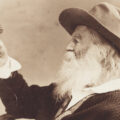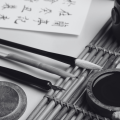Hyperbaton is a literary device that involves the transposition or inversion of the normal order of words in a sentence, phrase, or clause. This deliberate rearrangement of words is used to create emphasis, enhance the rhythm, or add complexity to the language. The term “hyperbaton” is derived from the Greek word “ὑπερβατόν,” which means “transposed” or “inverted.”
As a figure of speech, hyperbaton is often employed in poetry of all kinds, but particularly in free verse poetry, to break the usual sentence structure and create a more poetic effect. By altering the natural word order, writers can draw attention to specific words or phrases, create ambiguity, or challenge the reader’s expectations.
Contents
Dictionary Definitions of Hyperbaton
While I’m not a fan of repeating dictionary definitions of any literary term, according to the Merriam-Webster dictionary, hyperbaton is defined as “a transposition or inversion of idiomatic word order (as in ‘cheese I love’).” The Oxford English Dictionary defines it as “a figure of speech in which the normal order of words is reversed, especially for the sake of emphasis.”
The Collins English Dictionary provides a more detailed definition: “Hyperbaton is a figure of speech in which the normal order of words in a sentence, phrase, or clause is reversed, usually for the sake of emphasis or to create a particular effect.”
Examples of Hyperbaton in Poetry:
Hyperbaton is a common literary device used in poetry to create emphasis, ambiguity, or poetic effect. Here are some examples of hyperbaton in poetry:
“The Waste Land” by T.S. Eliot
In the opening lines of “The Waste Land,” T.S. Eliot uses hyperbaton to create a sense of disorientation and fragmentation:
“April is the cruellest month, breeding
Lilacs out of the dead land, mixing
Memory and desire, stirring
Dull roots with spring rain.”
In this example, the normal word order would be “April, the cruellest month, is breeding lilacs out of the dead land, mixing memory and desire, and stirring dull roots with spring rain.” By inverting the word order, Eliot creates a sense of disorientation and emphasizes the cruelty of April.
“Sonnet 116” by William Shakespeare
In “Sonnet 116,” Shakespeare uses hyperbaton to emphasize the enduring nature of love:
“Love is not love
Which alters when it alteration finds,
Or bends with the remover to remove.”
The normal word order would be “Love, which alters when it finds alteration or bends with the remover to remove, is not love.” By inverting the word order, Shakespeare emphasizes the idea that true love is constant and unchanging.
“The Raven” by Edgar Allan Poe
In “The Raven,” Poe uses hyperbaton to create a sense of mystery and intrigue:
“Once upon a midnight dreary, while I pondered, weak and weary,
Over many a quaint and curious volume of forgotten lore—
While I nodded, nearly napping, suddenly there came a tapping,
As of some one gently rapping, rapping at my chamber door.”
The normal word order would be “Once, upon a dreary midnight, while I pondered over many a quaint and curious volume of forgotten lore, weak and weary, suddenly there came a tapping, as of some one gently rapping at my chamber door, while I nodded, nearly napping.” By inverting the word order, Poe creates a sense of mystery and intrigue, drawing the reader into the poem.
Why Do Poets Use Hyperbaton?
Poets use hyperbaton for several reasons:
- To create emphasis: By inverting the normal word order, poets can draw attention to specific words or phrases, making them stand out and giving them greater importance.
- To create ambiguity: Hyperbaton can create multiple meanings or interpretations of a phrase or sentence, allowing the reader to engage with the poem on a deeper level.
- To create poetic effect: Hyperbaton can create a sense of rhythm, sound, or imagery that enhances the overall impact of the poem.
- To challenge the reader: By breaking the normal word order, hyperbaton can make the poem more challenging and engaging for the reader, encouraging them to think more deeply about the meaning and structure of the poem.
Hyperbaton and Other Literary Devices
Hyperbaton is often used in conjunction with other literary devices to create a more powerful effect. Some of the devices that can be combined with hyperbaton include:
- Anastrophe: Anastrophe is a specific type of hyperbaton that involves the inversion of the normal word order in a sentence or phrase, whereas hyperbaton can be the inversion of the normal word order in any utterance, writing, etc. For example, “Of all the gin joints in all the towns in all the world, she walks into mine” (Casablanca, 1942).
- Chiasmus: Chiasmus is a rhetorical device that involves the repetition of words or phrases in reverse order. When combined with hyperbaton, it can create a striking and memorable effect. For example, “Ask not what your country can do for you; ask what you can do for your country” (John F. Kennedy, Inaugural Address, 1961).
- Enjambment: Enjambment is the continuation of a sentence or phrase from one line of poetry to the next without a pause. When used with hyperbaton, it can create a sense of flow and movement in the poem, as well as emphasize specific words or phrases.
Examples of Hyperbaton in Everyday Speech
Hyperbaton is not limited to poetry and literature; it can also be used in everyday speech for emphasis or effect. Here are some examples:
- “A fool, you are” instead of “You are a fool.”
- “In the garden, the flowers bloom” instead of “The flowers bloom in the garden.”
Hyperbaton is a powerful literary device that can be used to create emphasis, ambiguity, and poetic effect in poetry. By inverting the normal word order, poets can challenge the reader, create multiple meanings, and enhance the overall impact of the poem. Whether used in poetry or everyday speech, hyperbaton is a figure of speech that can add depth and complexity to language.
- Glossary of Japanese Poetry Terms - 26 February 2025
- What is Waka Poetry? - 23 May 2024
- How to Identify the Kigo in a Haiku: - 22 March 2024




